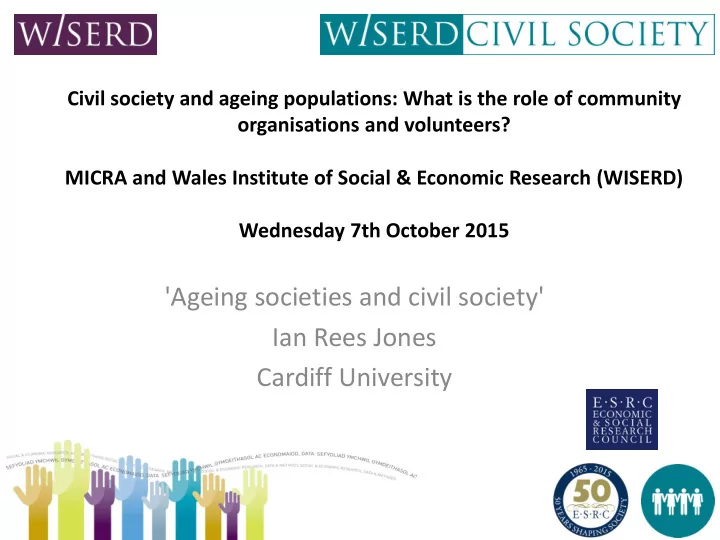

Civil society and ageing populations: What is the role of community organisations and volunteers? MICRA and Wales Institute of Social & Economic Research (WISERD) Wednesday 7th October 2015 'Ageing societies and civil society' Ian Rees Jones Cardiff University
Civil Society and Old Age From the sixteenth century… “the emergence of civil society was itself a key to understanding the invention of a special status of being old or elderly” John Keane (2008)
“Like nailing a pudding to a wall” • “the sphere of ideas, values, institutions, organisations, networks, individuals located between the family, the state, and the market and operating beyond the confines of national societies, polities and economies” ( Anheir 2001 on Global Civil Society). • A specific type of social action • A specific social sphere • A core utopian project
Contested and paradoxical • A realm of dialogue and human relations that is connected to, but separate from, the state, markets and private life (Kocka 2004). • Multi-layered and encompasses a diverse range of associational life including charities, self-help groups, voluntary organisations, community groups, non- governmental organisations, pressure groups and social movements, trade unions as well as sport, leisure and arts societies (Perez-Diaz 2011), • Long term decline with deleterious effects for social cohesion (Putnam 2000). • Non-governmental space of plurality, transparency, rights based approaches and solidarity (Alexander 1998) • An alternative to statism most recently conveyed through the rhetoric of a ‘Big Society’ (Edwards 2012).
Changing forms of Civil society • Previous values of persuasion, influence and charity • Based increasingly on ethical and rights based concerns • Replaced by new social networks of trust, reflexivity and reciprocity, Solidarity and Subsidiarity (Castells, Donati) • Professionalisation and marketisation of Civil Society Organisations • Global/National/Local Organisational levels (tensions) • New Social Media (Arab Spring)
Civil Society and Later Life • Studies of social participation in later life have focused on how engagement in retirement (participating in activities, volunteering and local politics) leads to mutually beneficial effects for the well-being of older people and the communities they inhabit. • Seem by some as a positive response to the apocalyptic narratives of ageing • Actively promoted by government and NGOs • BUT – Productivism (Walker and Maltby 2012) – Successful ageing (young old v old old) – younger generations more engaged in new civil society forms
Frameworks for understanding civic engagement in later life • Norms – Labour market norms, retirement norms, age discrimination, consumption, institutional ageism • Values – Democratic institutions, religious institutions (possible spill over effects to secular institutions), social capital, path dependency • Structures – Welfare state regime types, family types – Crowding in, crowding out, contingency • Hank (2011) McNamara and Gonzales (2011)
Findings on Volunteering and Civic Engagement in later life • Definitional and Measurement Problems – Formal, Informal, voting, membership, activity, scale of institutions • Patterns – Age, gender, education, SES, Family and Kinship, Health, Labour market, welfare states, religion, family forms, Country (USA v Europe and Within Europe), time • Motives – Altruism, helping others, future generations, connection to community, duty, values, morals, mixed with egoistic motives, meeting people, increasing skills, personal pleasures • Barriers/Facilitators to engagement – Age discrimination in orgs and institutions, stereotypes, transport/access, costs, psychological barriers • Impact and well-being/health outcomes – Health status, use of services, individual and community networks BUT Causal direction is difficult
Policy • Europe – Lifelong Learning and Active Citizenship in Europe (LACE); European Older People’s Platform; Retired and Senior Volunteering Programme in UK • USA – Senior Corps Programmes; Retired and Senior Volunteer Programme (RSVP), Senior Companions Programme (SCP) Foster Grandparents Programme (FGP)
Policy Implications • Third Sector changes – Shift from charity models to social enterprise model could exclude older people • Recruitment strategies – word of mouth, on a group basis, in mid life while still working • Economic incentives – transport costs, tax credits, vouchers • Volunteering and intergenerational relations – Generativity • State retrenchment – Cost savings
Questions – What roles are older people being encouraged to play? – What roles do older people want to play? – What meanings are associated with these roles? – What are the economic and political driving forces? – What types of associational life are not included? – What might this mean for inter-generational relations? – Is there a civil/civic pattern in later life? – In what spheres (economic, political, social normative, cultural value) are older people active?
Today’s presentations • Dr Martijn Hogerbrugge: 'Comparative perspectives on volunteering in Europe' • Dr Martina Feilzer: 'Intergenerational aspects of fear of crime' • Dr Tanja Bastia: 'Dreams and aspirations in later life: grassroots organising and activism by migrants’ elderly parents in Bolivia'
Recommend
More recommend